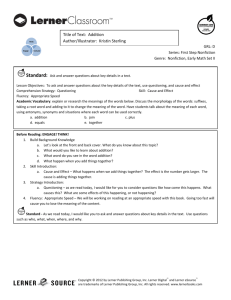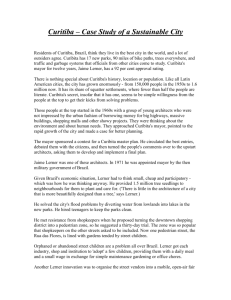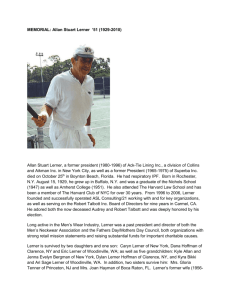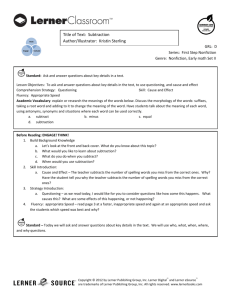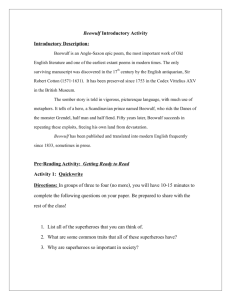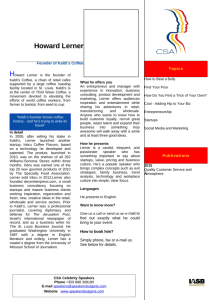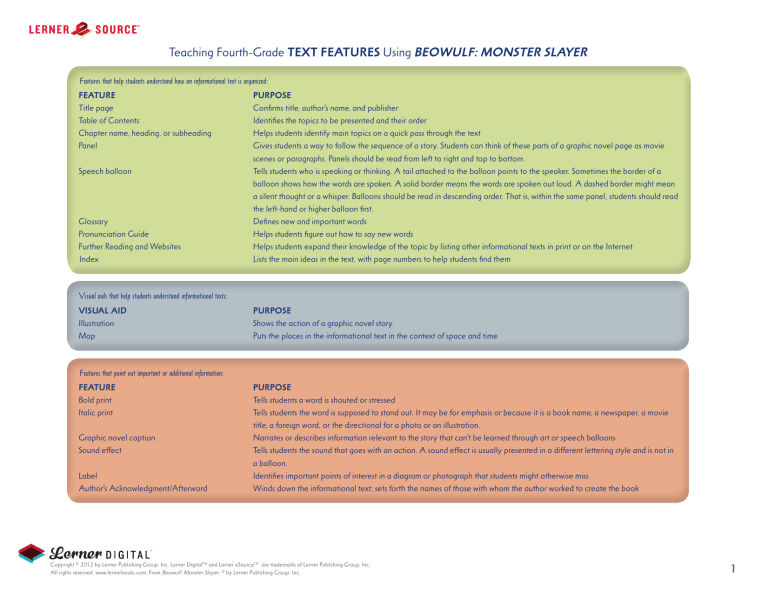
Teaching Fourth-Grade TEXT FEATURES Using BEOWULF: MONSTER SLAYER
Features that help students understand how an informational text is organized:
FEATURE
PURPOSE
Title page
Confirms title, author’s name, and publisher
Table of Contents
Identifies the topics to be presented and their order
Chapter name, heading, or subheading
Helps students identify main topics on a quick pass through the text
PanelGives students a way to follow the sequence of a story. Students can think of these parts of a graphic novel page as movie
scenes or paragraphs. Panels should be read from left to right and top to bottom.
Speech balloonTells students who is speaking or thinking. A tail attached to the balloon points to the speaker. Sometimes the border of a
balloon shows how the words are spoken. A solid border means the words are spoken out loud. A dashed border might mean
a silent thought or a whisper. Balloons should be read in descending order. That is, within the same panel, students should read
the left-hand or higher balloon first.
Glossary
Defines new and important words
Pronunciation Guide
Helps students figure out how to say new words
Further Reading and WebsitesHelps students expand their knowledge of the topic by listing other informational texts in print or on the Internet
Index
Lists the main ideas in the text, with page numbers to help students find them
Visual aids that help students understand informational texts:
VISUAL AID
Illustration
Map
PURPOSE
Shows the action of a graphic novel story
Puts the places in the informational text in the context of space and time
Features that point out important or additional information:
FEATURE
PURPOSE
Bold print
Tells students a word is shouted or stressed
Italic printTells students the word is supposed to stand out. It may be for emphasis or because it is a book name, a newspaper, a movie
title, a foreign word, or the directional for a photo or an illustration.
Graphic novel captionNarrates or describes information relevant to the story that can’t be learned through art or speech balloons
Sound effectTells students the sound that goes with an action. A sound effect is usually presented in a different lettering style and is not in
a balloon.
LabelIdentifies important points of interest in a diagram or photograph that students might otherwise miss
Author’s Acknowledgment/AfterwordWinds down the informational text; sets forth the names of those with whom the author worked to create the book
™
Copyright © 2012 by Lerner Publishing Group, Inc. Lerner DigitalTM and Lerner eSourceTM are trademarks of Lerner Publishing Group, Inc.
All rights reserved. www.lernerbooks.com. From Beowulf: Monster Slayer. © by Lerner Publishing Group, Inc.
1
TITLE PAGE: This page tells you
what the name, or the title, of the
book is. It also tells you who wrote
the book and who published it.
MAP: This is a flat
drawing that shows
the shape and
features of a place,
such as a country,
a state, or a city.
The title of the map
may be at the top
of the drawing.
LABELS: These
graphic universe • minneapolis
tm
GRAPHIC NOVEL: This is a
story told in the form of a comic book.
are words in a
diagram or photo
that point out
important parts
of the diagram
or photo. On
a map, labels
name important
features, such as
rivers or cities.
™
Copyright © 2012 by Lerner Publishing Group, Inc. Lerner DigitalTM and Lerner eSourceTM are trademarks of Lerner Publishing Group, Inc.
All rights reserved. www.lernerbooks.com. From Beowulf: Monster Slayer. © by Lerner Publishing Group, Inc.
2
TABLE OF
CONTENTS: This
lists the chapters in your
book by chapter title and
the pages on which they
begin. The contents might
also list features, such as
the index, that are at the
end of the book.
table of contents
the coming of beowulf . . . 6
the horror of heorot . . . 8
grendel . . . 16
a mother’s revenge . . . 22
beowulf the king . . . 33
the dragon . . . 37
the funeral of beowulf . . . 45
glossary and pronunciation guide. . . 46
further reading and websites . . . 47
creating beowulf : monster slayer. . . 47
Index . . . 48
about the author and the artist . . . 48
™
Copyright © 2012 by Lerner Publishing Group, Inc. Lerner DigitalTM and Lerner eSourceTM are trademarks of Lerner Publishing Group, Inc.
All rights reserved. www.lernerbooks.com. From Beowulf: Monster Slayer. © by Lerner Publishing Group, Inc.
3
CHAPTER
TITLE: This tells
you what topic will
be discussed in the
chapter. Chapter
titles often give
you the main
ideas of the book.
ILLUSTRATION:
The artwork in a
graphic novel shows
the action of the
story.
6
™
Copyright © 2012 by Lerner Publishing Group, Inc. Lerner DigitalTM and Lerner eSourceTM are trademarks of Lerner Publishing Group, Inc.
All rights reserved. www.lernerbooks.com. From Beowulf: Monster Slayer. © by Lerner Publishing Group, Inc.
4
PANEL: This is a
section of a comic
book page that
has its own image
and text. Panels are
like movie scenes
that show you the
sequence of the story.
GRAPHIC
NOVEL
CAPTION:
This is boxed
text within a
panel. Captions
narrate or give
information
relevant to the
story that can’t be
learned through
either art or
speech balloons.
SPEECH BALLOON:
This is a rounded shape
that holds the dialogue of
one of the characters in a
graphic novel story. A tail
points to the character who
is speaking. A solid balloon
border means the words are
spoken out loud. A dashed
balloon border might
mean a silent thought or
a whisper. Within a panel,
you should read the lefthand or higher balloon first.
7
™
Copyright © 2012 by Lerner Publishing Group, Inc. Lerner DigitalTM and Lerner eSourceTM are trademarks of Lerner Publishing Group, Inc.
All rights reserved. www.lernerbooks.com. From Beowulf: Monster Slayer. © by Lerner Publishing Group, Inc.
5
SOUND
EFFECT: This tells
you the sound of an
action going on in a
panel. The sound is
usually in a different
type style than
speech balloons.
BOLD PRINT: This
helps a word stand out.
It might be a shouted
word. Bold print is also
used in the glossary.
40
™
Copyright © 2012 by Lerner Publishing Group, Inc. Lerner DigitalTM and Lerner eSourceTM are trademarks of Lerner Publishing Group, Inc.
All rights reserved. www.lernerbooks.com. From Beowulf: Monster Slayer. © by Lerner Publishing Group, Inc.
6
HEADINGS AND
SUBHEADINGS: These separate
glossary and pronunciation guide
the main text into smaller chunks of
information. A heading tells you what
the section below it is about.
barrow: a mound of dirt or stones
heorot (HAIR-ut): King
beowulf (BAY-uh-wulf): the warrior
herald: a person who carries
dragon: a scaly, serpentlike creature
hilt: the end of a sword used as a
that marks a person’s burial place
hero of Beowulf, an Old English
epic from A.D. 700–800
from mythology. Many countries
have stories about dragons. In
China and Japan, they are
symbols of good luck. But in
European mythology, dragons
are dangerous, fire-breathing
killers. In English myths, they
are sometimes called worms.
GLOSSARY: This is a list of
important new words that you have
learned by reading the book. Each
glossary word is in bold letters. After
the bold word is a phrase that tells the
meaning of the word.
handgrip
hrothgar (HRAHTH-gahr): a
king of Denmark
hrunting (HRUN-ting): the sword
given to Beowulf by Unferth
hygelac (HOO-yuh-lahk): the king
enchantment: a magical spell that
mail: a material used in making
influences the physical world,
either by causing something to
happen or by preventing it
fens: wetlands usually covered by
pools of water, grasses, and reeds
geatland (yay-AHT-lond): a region
in the southwestern corner of
modern Sweden
geats (yay-AHTS): people from
Geatland. Beowulf and his
soldiers were Geats.
unfamiliar or hard-to-say words
into short sounds. When put
together, the sounds help readers
pronounce, or say, the words.
messages and announces
information
ecgtheow (EDGE-theh-ow):
Beowulf’s father
PRONUNCIATION
GUIDE: This breaks down
Hrothgar’s mead hall
helm: a metal helmet worn in battle
of the Geats
medieval soldiers’ protective
gear, such as byrnies. Mail was
made from small circles of
hammered metal linked together
to form a fabric. Mail is often
called chain mail.
mead: an alcoholic drink made from
honey and fruit
mead hall: a gathering place for
dining and socializing
thane: a king’s attendant. Thanes
were usually soldiers to whom the
king gave land in return for
military service.
46
™
Copyright © 2012 by Lerner Publishing Group, Inc. Lerner DigitalTM and Lerner eSourceTM are trademarks of Lerner Publishing Group, Inc.
All rights reserved. www.lernerbooks.com. From Beowulf: Monster Slayer. © by Lerner Publishing Group, Inc.
7
FURTHER
READING: This is a list
of books and websites on
the same subject as the
book you just read. The list
is at the end of your book.
further reading and websites
The Anglo-Saxons
http://www.bbc.co.uk/schools/anglosaxons/index.shtml
The “Schools” section of the British Broadcasting Corporation’s homepage
features a history of the Anglo-Saxons. How the Anglo-Saxons came to the
British Isles, how they lived, what religious beliefs they held, and other facets
of Anglo-Saxon life are discussed. Each topic includes links to a glossary.
Beowulf
http://www.bl.uk/onlinegallery/themes/englishlit/beowulf.html
The Online Gallery of the British Library features information about the last
remaining copy of the original Beowulf manuscript and a brief explanation of
the epic poem’s importance to English literature. The gallery also features an
image of a page from the one-thousand-year-old manuscript.
ITALIC: This type is slanted to
make a word or a phrase stand
out. Italicized words may be
names of books, newspapers,
movies, ships, or foreign words.
They may also tell you which
caption goes with which photo.
Crossley-Holland, Kevin. Beowulf. Illustrated by Charles Keeping. Oxford:
Oxford University Press, 1987. Crossley-Holland retells the Anglo-Saxon
epic in prose for young readers. The story is accompanied by Keeping’s blackand-white illustrations.
creating beowulf: monster slayer
In creating the story, author Paul D. Storrie used well-known translations of
Beowulf, including the translation (with introduction) by Burton Raffel, the
Donaldson translation (with background, sources, and criticism) edited by Joseph
F. Tuso, and an Oxford University Press translation by Ian Serraillier. Artist
Ron Randall used sources on Anglo-Saxon armaments, ships, clothing, and
architecture to shape the story’s visual details. Consultant Andrew Scheil of the
University of Minnesota provided expert guidance on historical details, textual
accuracy, and Anglo-Saxon pronunciation.
AFTERWORD: This
section usually comes
after the main text. It tells
the reader the names of
people or groups that
helped during the research
and writing of the book.
original pencil from page 39
™
Copyright © 2012 by Lerner Publishing Group, Inc. Lerner DigitalTM and Lerner eSourceTM are trademarks of Lerner Publishing Group, Inc.
All rights reserved. www.lernerbooks.com. From Beowulf: Monster Slayer. © by Lerner Publishing Group, Inc.
8
index
INDEX: This is an
alphabetical list of words
at the end of your book.
The index tells some of
the book’s main ideas.
Each word is followed
by page numbers. These
numbers tell you where
to go in the book to find
that main idea.
Beowulf: battle with Grendel, 17–21;
battle with Grendel’s mother, 26–29;
death of, 44; decision to travel to
Denmark, 6, 10; fighting the dragon,
37–43; funeral of, 45; legendary
strength of, 6, 11; named king of the
Geats, 33
Brecca, 13–14
Grendel’s mother, 22, 23, 24, 25; battle
with Beowulf, 25–29
Denmark, 6, 7
North Sea, 6
Ecgtheow, 7, 11
Sweden, 6
Geatland, 6
Geats, 7, 11
Grendel, 9, 12, 13, 15, 20, 21, 22, 29, 36;
battle with Beowulf, 17–21
Unferth, 13, 14, 24, 32
Heorot, 7, 8, 10, 30
Hrothgar, 7, 8, 11, 21, 22, 24, 31, 32; as
friend of Beowulf’s father, 6, 12, 13
Hrunting, 24, 26, 29, 32
Hygelac, 7, 12, 24, 32
Wealhtheow, 15
Wiglaf, 39, 40, 43–44, 45
about the author and the artist
paul d. storrie
was born and raised in Detroit, Michigan. He has returned to
live there again and again after living in other cities and states. He began
writing professionally in 1987 and has written comics for Caliber Comics,
Moonstone Books, Marvel Comics, and DC Comics. His Graphic Myths and
Legends work includes Hercules: The Twelve Labors; Robin Hood: Outlaw of
Sherwood Forest; Yu the Great: Conquering the Flood; and Amaterasu: Return
of the Sun. He had also written Robyn of Sherwood (featuring stories about
Robin Hood's daughter); Batman Beyond; Gotham Girls; Captain America:
Red, White and Blue; Mutant X; and Revisionary.
ron randall has drawn comics for every major comic publisher in the United
States, including Marvel, DC, Image, and Dark Horse. His Graphic Myths
and Legends work includes Thor & Loki: In the Land of Giants and
Amaterasu: Return of the Sun. He has also worked on superhero comics such
as Justice League and Spiderman; science fiction titles such as Star Wars and
Star Trek; fantasy adventure titles such as DragonLance and Warlord;
suspense and horror titles including SwampThing, Predator, and Venom; and
his own creation, Trekker. He lives in Portland, Oregon.
48
™
Copyright © 2012 by Lerner Publishing Group, Inc. Lerner DigitalTM and Lerner eSourceTM are trademarks of Lerner Publishing Group, Inc.
All rights reserved. www.lernerbooks.com. From Beowulf: Monster Slayer. © by Lerner Publishing Group, Inc.
9

